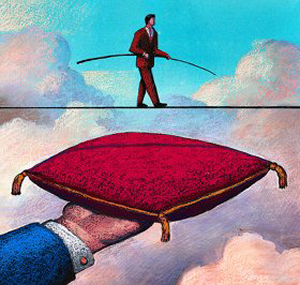Words of cautious wisdom from the celebrated biographer of risk, back in November of 2007…
Crazy Little Thing Called Risk
By PETER L. BERNSTEIN
 BACK when I was managing other people’s money, I had a client, a doctor, who enjoyed giving away money to his daughters. He was lucky, because an extended bull market was under way with only minor interruptions. The more he gave away, the more the market replaced what he had parted with. As generosity appeared to be a cost-free form of recreation, he considered the whole thing a riskless enterprise.
BACK when I was managing other people’s money, I had a client, a doctor, who enjoyed giving away money to his daughters. He was lucky, because an extended bull market was under way with only minor interruptions. The more he gave away, the more the market replaced what he had parted with. As generosity appeared to be a cost-free form of recreation, he considered the whole thing a riskless enterprise.
Whenever I saw my client, he immediately thanked me for making him whole after his most recent spate of giving. I always had to remind him that his gratitude was misplaced. Don’t thank me, I warned him. Thank all those nice people who are willing to pay higher prices today for the stocks you bought earlier at lower prices.
This client, who assumed that the steady multiplication of his money would continue indefinitely, without risk, keeps popping up in my memory. Although this episode happened back in the 1950s, it contains a deep truth worth exploring now, because his experience gets to the roots of what investment risk is all about.
A naïve approach to risk might have been appropriate in an era when economic activity was almost totally agricultural. For most of human history, in fact, the main source of economic risk was the weather. But nobody can do anything about the weather. Risk management in those days was therefore a matter of religion, incantation or superstition. Rain dances in one area were matched by novenas in another. Appeals to God’s will or the fates seemed to be the only way to deal with the risks that weather could wreak.
That model of risk management changed radically during the Industrial Revolution. As more and different kinds of goods and services came to market, a wide variety of risks replaced the longstanding and single-minded concerns about the weather. What will our suppliers charge? Will customers pay the prices we set? Will they want the new products we are developing? Will our competitors beat us to the punch? Will they start a price war? Should we raise our employees’ wages, and, if so, by how much? Can the engineers rearrange our production to be more efficient? Will our bankers smile or frown when we seek credit? Will our interest rates rise or fall?
Today, risk has shifted from a bet on what nature will provide to an intricate series of bets on what other players in the economy will decide — and how each will respond to the others’ decisions. Instead of a throw of the dice, economic activity has become an intense interchange among companies, employees, suppliers, customers, owners, borrowers, lenders and financiers. The interaction has become more complex over time, so the answers to the above questions will in turn provoke new questions, answers and decisions among these groups.
Most important, the essence of risk itself has been fundamentally transformed. Risk today depends upon the consequences of what somebody else will do, not on what God or nature will provide. Risk management means protecting oneself from the adverse and unexpected decisions others may make and, in the process, making better decisions than they do. John von Neumann, who developed game theory, referred to these interactive patterns of decision-making as the sphere of combat and competition.
My client acted as if his portfolio was immune from others’ adverse choices. He wasn’t alone in that thinking then, and he wouldn’t be alone now. A look at recent events shows that many investors are following in his footsteps. Three months ago, for example, subprime paper was an investment rated Aaa for most investors, which meant they believed they were virtually certain of receiving the return they expected. But then homeowners began to default on their subprime mortgages, and suddenly, the paper was risky, because other investors were making adverse decisions. People who wanted to sell their homes found that prospective buyers were offering much less, and homeownership was suddenly transformed from riskless to risky.
In recent weeks, chief executives have departed from leading financial institutions like Citigroup and Merrill Lynch. Such institutions have hit the headlines for the magnitude of their losses, which occurred because other investors wanted to pay lower prices for the exotic financial assets the banks had been so comfortable holding. Those assets appeared risky. And then investors reduced the prices they would pay for all types of financial assets that they feared had become too risky to attract buyers. And so on down the line.
It is not the market that is rising or falling at any moment, even if we commonly speak as though it were. In truth, prices move in response to the buying and selling decisions of countless investors, who are constantly considering the likely decisions of countless others. Incantation may still go on — for example, “In the long run, stocks will always go up†— but it may not change the decisions of other investors.
In the 1950s, those other investors made my doctor-client happy. Today, he would have no reason to thank them or me.